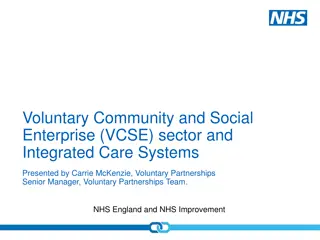Mid-Year Sector Review: Healthcare Insights
This mid-year sector review delves into the healthcare industry, highlighting key aspects such as companies catering to health needs, market segments, sector outlook, recent headlines, macroeconomics, and key drivers like governmental regulation, R&D, and the economy. The analysis covers a range of factors influencing the sector, from demographic trends to technological advancements, providing valuable insights into the current state and future prospects of the healthcare industry.
Download Presentation

Please find below an Image/Link to download the presentation.
The content on the website is provided AS IS for your information and personal use only. It may not be sold, licensed, or shared on other websites without obtaining consent from the author.If you encounter any issues during the download, it is possible that the publisher has removed the file from their server.
You are allowed to download the files provided on this website for personal or commercial use, subject to the condition that they are used lawfully. All files are the property of their respective owners.
The content on the website is provided AS IS for your information and personal use only. It may not be sold, licensed, or shared on other websites without obtaining consent from the author.
E N D
Presentation Transcript
Mid-Year Sector Review: Healthcare By: Jacob Allen; Nick Pascoe; Trevor Boren; Garrett Lachney; Joe Brendel
Overview Companies that cater to the needs of people through pharmaceuticals, hospitals, doctors offices, nursing homes, and other health-related facilities Demand: demographics & advances in technology Segments Drug manufacturers, biotechnology, medical supplies/equipment
Current State of Sector Professional Viewpoint: Slightly Bullish Baby Boomer Population Life expectancy approaching 80 in the US Political Viewpoint: Uncertain Affordable Care Act Politics in Healthcare
Recent Headline News Bright Horizons & LipoScience IPO expected this week Brean analyst Jon Aschoff downgraded Celsion shares last Thursday shares dropped 32% that day (ended with a 13% loss on the day) Obama s 2nd inaugural address and healthcare
Macroeconomics Healthcare sector is usually described as defensive Demand for health services and products are essential and relatively constant across different economic expansions and contractions Not affected by cyclical forces or monetary policy as much as others Healthcare is, however, influenced by government regulation
Key Drivers Though the health care sector is very diverse in terms of the industries within it, there are some key drivers that apply to nearly all of them. Governmental Regulation: - Vast sums of money hinge on the acceptance of federal regulatory institutions. - The patent industry. Ageing Population: - This driver is very universal in its effects in the industry. - In general, any sharp increase in the population of unhealthy people will result in the healthcare industry seeing more business.
Key Drivers R&D: - R&D easily reaches into the billions on an annual basis. - Inability to innovate and come out with new and successful products, many times is attributed to shortfalls in research and design. The Economy: - Boils down to employment and government spending. - When the un-employment levels are high, the level of uninsured Americans increases. - When the economy starts to tumble government spending comes under increased scrutiny. Things like government subsidies for R&D, or grants for medical research are all at risk of being downsized.
Relevant Valuation Matrices As with the key drivers, some valuation matrices are more applicable to one industry than another within the healthcare sector. Though for the healthcare sector, there are some specific ratios that must be taken into consideration before actively investing. P/E and Forward P/E: - Though some industries within this sector can have slightly volatile earnings, the P/E ratio is still important to the more stable and mature companies in the sector. P/CF: - Many of the companies in the healthcare sector are very large, and have large portfolios of assets. This can lead to P/E ratio not showing a clear enough picture. So the P/CF ratio can give a more accurate picture of the value that a firm can return to shareholders.
Relevant Valuation Matrices PEG ratio: prospects, such as startup Pharmaceutical firms. The PEG ratio takes into account the potential for high relative growth, and therefore the comparison of PEG ratios must be between companies with above average growth prospects. Debt/equity: - Many companies in the sector, such as hospitals, have high amounts of debt. And due to various factors in the healthcare system, they are often left with a fair amount of uncollectible accounts. The ability to meet debt obligations is something that investors must examine thoroughly before taking a position in this sector. - This ratio is good for companies with high growth
HC Stock Recommendations UnitedHealth Group Inc. (UNH) - 10/11/12 Cardinal Health Inc. (CAH) - 10/16/12 DaVita (DVA) - 10/18/12 Johnson & Johnson (JNJ) - 10/23/12 WellPoint Inc. (WLP) - 10/30/12 Pfizer Inc. (PFE) - 11/8/12 Baxter (BAX) - 11/15/12 Eli Lilly (LLY) - 11/29/12 Stryker Corporation (SYK) - 11/29/12
United Health Group (UNH) Date Presented: Oct. 11 Recommendation: No Vote: N/A Price Then: $57.66 Price Now: $55.74
Cardinal Health Inc. (CAH) Date Presented: Oct. 16 Recommendation: Buy Vote: No Price Then: $42.05 Price Now: $44.61
DaVita (DVA) Date Presented: Oct. 18 Recommendation: Buy Vote: No Price Then: $109.87 Price Now: $114.68
Johnson & Johnson (JNJ) Date Presented: Oct. 18 Recommendation: No Vote: No Price: $71.86 Price Now: $72.70
WellPoint Inc. (WLP) Date Presented: Oct. 30 Recommendation: Buy Vote: Yes Price Then: $61.01 Price Now: $63.60 Earnings released today: Profits surge, beat estimates
Pfizer (PFE) Date Presented: Nov. 8 Recommendation: Yes Vote: No Price: $24.71 Price Now: $26.65
Baxter International (BAX) Date Presented: Nov. 15 Recommendation: No Vote: No Price: $65.95 Price Now: $66.95
Eli Lilly (LLY) Date Presented: Nov. 29 Recommendation: No Vote: N/A Price Then: $48.58 Price Now: $53.29
Stryker Corporation (SYK) Date Presented: Nov. 29 Recommendation: No Vote: N/A Price Then: $54.05 Price Now: $61.56
Cyclicality The Health Care Sector (XLV) is very non-cyclical. Defensive stock Low beta: 0.66 Health is always a top priority Not affected much during weakened economy
Industry Cyclicality Most of the Health Care sectors are non-cyclical. The biotechnology industry is the most cyclical. Due to being heavily tied in with technology
Sources Reuters.com Finance.Yahoo.com http://www.rttnews.com/2041816/wellpoint-q4- profit-surges-beats-view-sees-lower-fy13- earnings.aspx?type=corp























